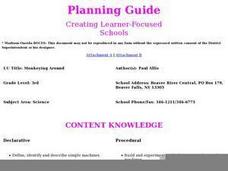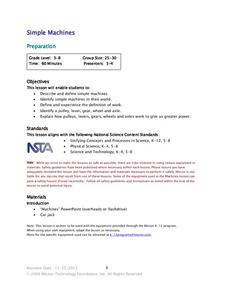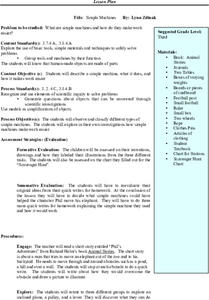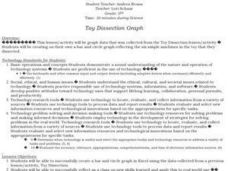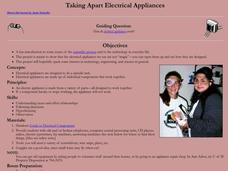Curated OER
Creating My Own Rube Goldberg Machine
Students dissect simple machines. In this simple machines lesson, students gather simple machines from their home to dissect in class. Students investigate the working parts of simple machines and construct a machine based on the designs...
Curated OER
Design Your Own Rube Goldberg Machine
Students participate in a culminating activity for a unit on Energy and Simple Machines. They are challenged to incorporate simple machines in to a complex mechanical system. While designing and testing their machine they will also...
Curated OER
Design Your Own Rube Goldberg Machine
Students design and construct a Rube Goldberg machine that accomplishes a simple task in at least ten steps. They view and discuss various Rube Goldberg designs, identify types of simple machines, and in small groups produce a schematic...
Curated OER
Simple Machines In Action
Students name and recognize six types of simple machines. They use their research to design an amusement park ride that features different types of simple machines. Students create a brochure about their ride and how it works. Simple...
Curated OER
Simple machines
Students list and describe the six simple machines. They create a Thinking Map and outline using Kidspiration and create a paper on the importance of simple machines using Microsoft Word.
Curated OER
My Machine
Third graders explore how simple machines can affect their health and lifestyle. In addition, 3rd graders use their knowledge of simple machines to build a unique machine.
Curated OER
Can You Do It?
Students create a simple machine to help with the design of the traditional can opener. In this simple machines lesson plan, students analyze the can opener, and use the design process to solve problems.
Curated OER
Monkeying Around
Third graders study machines. They watch a video about and identify and chart machines they find at home and at school. They design and build simple and compound machines, create an advertisement for them and attempt to sell them at the...
Curated OER
Who is Rube Goldberg?
Fifth graders practice technology skills while searching online for information about inventor, Rube Goldberg. They discuss Rube Goldberg's use of simple machines, and write journal entries about their findings.
Teach Engineering
Design Step 6: Evaluate/Manufacture a Final Product
This is what all of the excitement has been building up to! Young engineers create engineering drawings, use machines to manufacture their products, test, and evaluate their designs in the last step in the engineering design...
Curated OER
Simple Machines
Fourth graders choose a simple machine and write about they way they believe it will work. Students experiment, write down procedures used and record observations. They will find a picture of the machine and add it to their report.
Curated OER
The Solar System: Go Green with the Sun!
Third graders learn how to use solar power. In this sun, technology and energy lesson, 3rd graders learn how the solar power from the sun can give off energy, learn about solar panels, discuss their uses and benefits, and design a...
Curated OER
Don't Crack Humpty
Students investigate the engineering design process and the relationship between distance, time, and speed. Using a generic car base, small groups design a device that will protect an egg on or in the car as it is rolled down a ramp at...
Curated OER
Simple Machines
Third graders listen to a short story entitled, "Phil's Adventures" from a book called Animal Stories. They stop at each obstacle in the story and do a quick write about how they would overcome the obstacle and draw a picture to...
Curated OER
Pooper Scooper
Science Students build a pooper scooper tool that helps them clean up after a dog without getting their hands dirty or their noses too close. They research the diseases that can be transported through animal waste and work in teams to...
Curated OER
Homer Price
An engaging and unique activity that combines literature and economics is here for you. In it, learners read the short story, "The Doghnuts" found in the book Homer Price. Pupils define "capital resources," and utilize a worksheet...
Curated OER
The DIY: A Hands-On Look at the New Industrial Revolution
Upper graders explore the new industrial revolution and how the tech boom in recent years is similar and different to the Industrial Revolution of the past. They watch a video, explore web sites, and discuss what they see. They work...
Philadelphia Museum of Art
Physics at the Art Museum: Kinetic Energy, Potential Energy, and Work
Connect science, math, and art for a true interdisciplinary lesson! Learners explore simple machines in art. Through analysis with a physics app, they identify positions of kinetic and potential energy and make conclusions about work.
Curated OER
Toy Dissection Graph
Students explore simple machines and how they are made. They examine the parts of the simple machine and collect information about its parts. Using Excel, students create circle and bar graphs from the collected data.
Curated OER
Ingenious Inventions
Fifth graders complete a variety of activities as they study the various tools and machines that have been invented throughout history that have made life easier and tasks less difficult for modern man.
Curated OER
Using Fabrics in Your Art Curriculum
Students use a dicut machine to do block printing on fabric. In this fabric lesson plan, students draw, carve, and print onto blocks for this art project.
Curated OER
Taking Apart Electrical Appliances
Students apply the scientific method to the act of taking apart appliances. In this scientific process lesson, students disassemble appliances to learn how their components work together.
Curated OER
Friction and Machines
Fifth graders experimentally determine the relationship of friction to the functioning of machines. They demonstrate that rollers can decrease frictional force and increase speed and research to discover other ways that friction can be...
Curated OER
Heirloom Machine Quilting
Young scholars practice using the sewing machine to make designs. After viewing demonstration, they discuss the best workspace, batting selections and how to prepare the quilt for use. They share their final quilt with the class.







